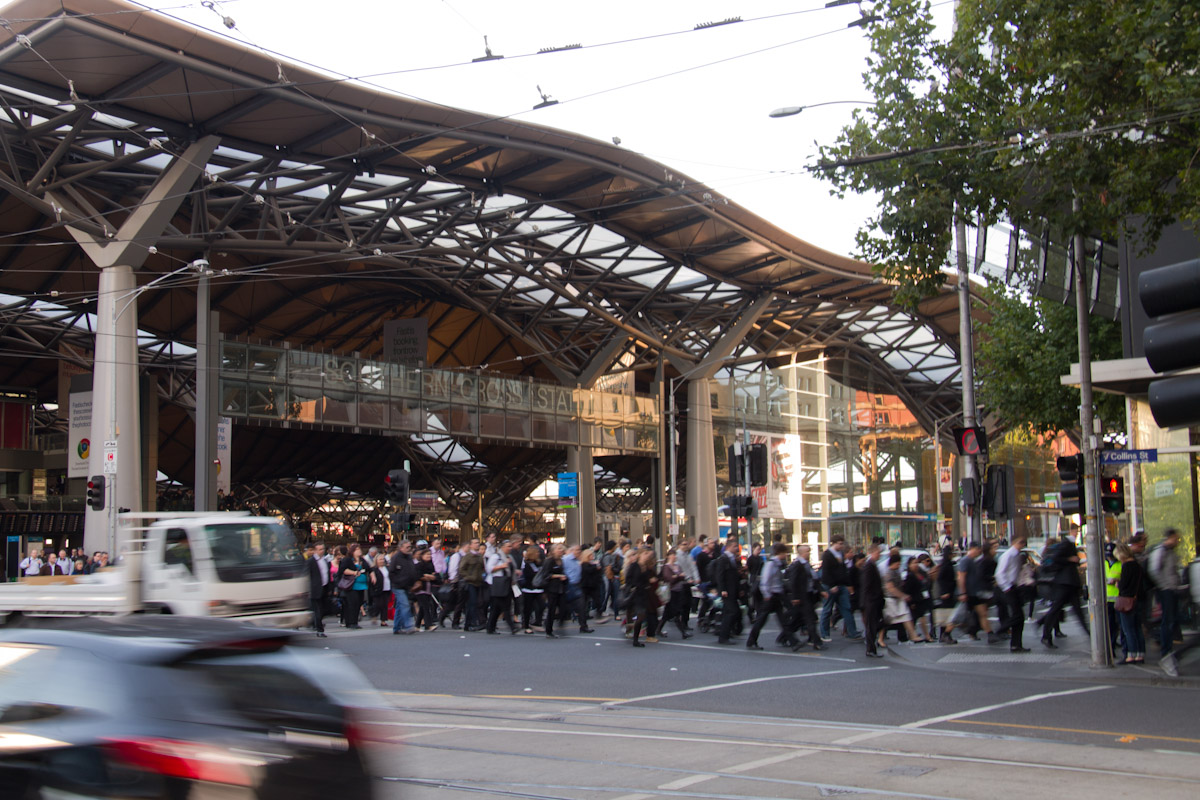The City of Melbourne is responsible for managing most of the pedestrian network in the municipality. Melbourne has an excellent pedestrian environment as a result of extensive work to create great streets over many years.
Bluestone footpaths and street trees enhance our public spaces and are a source of pride for many Melburnians. Street space previously given to private vehicles has been taken back for people to enjoy.
Despite this investment, the growth in jobs and population mean that our footpaths are becoming overcrowded. To improve conditions for pedestrians, a faster and bolder approach to changing the way space is used in the city will be required over the next 30 years. This will include reducing on-street car parking and removing lanes for private vehicle use as the city grows.
Overcrowding
Severe overcrowding frequently occurs at key locations across the central city, putting people at risk and undermining economic productivity.
- As growth in jobs and population continues, this overcrowding will get worse.
- This problem is particularly evident at intersections where large volumes of pedestrians are made to wait, such as outside Southern Cross Station, Flinders Street Station and the Collins/Swanston tram stops.
The walking economy and pedestrian delay
Walkable streets support business in the city which is dependent upon face-to-face interaction and the sharing of ideas.
- A failure to maintain quality streets as the population grows will hinder economic performance and erode Melbourne’s reputation as a desirable global city in which to reside, do business and visit.
- Increasing the level of walking connectivity by 10 per cent would increase the value of the Hoddle Grid economy by $2.1 billion per annum (6.6 per cent).
Safety, security and hostile vehicles
Pedestrian spaces which are not safe and secure compromise the quality of the walking environment.
- The City of Melbourne has the most pedestrian crashes of any municipality in Victoria.
- Poor perceptions of safety in some locations can undermine the city’s reputation and the night time economy. Recently, vehicles used as weapons have presented a new threat to our city.
- Reducing access for private vehicles in more places will reduce the risk of vehicle attacks.
Protective security measures need to be designed to improve the quality of the city.
Restricted mobility
Street design needs to be more inclusive to better serve the young, elderly, people with prams and people with a disability.
- It is a legal requirement that streets be accessible to all users and universal design principles benefit everyone.
- Places to rest, intuitive street signage and shade from trees are required.
- Pedestrian injuries from vehicles, trips and falls are unacceptably high.

Cities around the world are facing challenges similar to Melbourne. These global best practice ideas can help to inform the right approach for Melbourne.
Reduced traffic speeds in Dublin
Dublin has reduced default speed limits from 50 km/h to 30 km/h on most roads in its central city. Reducing speed limits has several benefits:
- It decreases the likelihood and severity of vehicle-pedestrian collisions: the chance of pedestrian death is 85% with a vehicle impact speed of 50km/h, 40% at 40km/h and 10% at 30km/h.
- Impacts on vehicle journey times in Dublin have been minimal, with most drivers trips increased by 20 seconds or less
- Slower streets are easier to cross.
30km/h speed limits in central Melbourne would improve safety for pedestrians with limited impacts on private vehicles.

Measuring pedestrian delay in Auckland
Pedestrian delays in central Auckland were measured and the cost of this delay was calculated using New Zealand guidelines for economic evaluation.
- The pedestrian delay at just one intersection on Queen Street in central Auckland was estimated to cost the economy NZD $2.2 million per annum.
- The study helped to build a robust economic case for allocating more time to pedestrians at signalised intersections in the city centre
- Testing of an optimised signal phasing showed that delay for walking could be reduced by 26 to 46 per cent
Signal changes in Melbourne to reduce pedestrian delay would have significant economic benefits.
- Street closures:
Traffic should be diverted away from some streets to create new car-free spaces, similar to Bourke Street Mall. Maintaining through movements for public transport, cycling and essential vehicles will be important. Amore people-friendly public realm is needed to provide space for people to rest, shop, do business and socialise as well as for movement. - Max 30km/h speed limits in the Hoddle Grid:
By reducing the speed of vehicles, safety will be substantially improved for all. Speed limits across the municipality should recognise pedestrian volumes and the activities taking place on the street. Speed reductions need to be complemented by street design improvements. - Reduce delays:
Reduce waiting time for pedestrians at traffic lights across the municipality so pedestrians can cross more often. This reduces the build-up of people waiting for the lights to change. At Spencer/Collins the pedestrian wait time could be reduced by 38 seconds. This would cut pedestrian crowding in the evening peak in half and people are less likely to cross against the lights. - Prioritise people over vehicles:
More space for people walking is required. Locations where overcrowding is already high include Flinders Street and Spencer Street. Rail capacity upgrades in the near future will increase significantly the number of people using our busiest stations. Removing traffic lanes and footpath widening will allow all pedestrians to be accommodated comfortably and safely.






